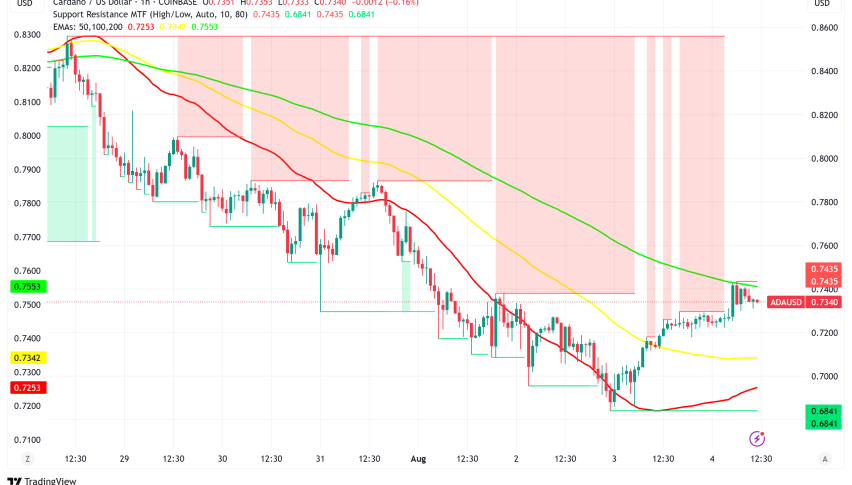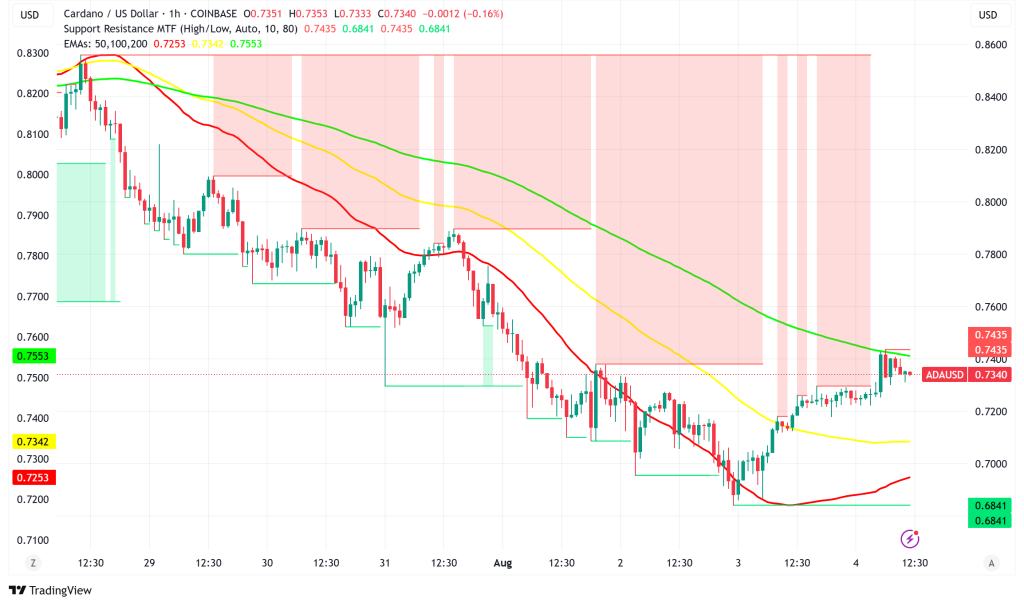Cardano Treasury Approves $71M Development Fund, ADA Tests Critical Support at $0.73
Cardano (ADA) is at a key point right now since the cryptocurrency is trading over $0.73 and has gained more than 2.6% in the last 24 hours.

Quick overview
- Cardano is currently trading over $0.73, having gained more than 2.6% in the last 24 hours, amidst significant changes in its blockchain ecosystem.
- The community approved a treasury plan to allocate 96 million ADA for core development, marking a milestone in Cardano's governance and decentralization efforts.
- While short-term technical indicators suggest potential downward pressure, long-term on-chain metrics indicate a growing user base and a positive outlook for future price movements.
- The network's upcoming upgrades and active community involvement may lead to increased investor interest and potential price recovery.
Cardano ADA/USD is at a key point right now since the cryptocurrency is trading over $0.73 and has gained more than 2.6% in the last 24 hours. There are big changes happening in the blockchain ecosystem that could affect its future, even though the price hasn’t changed much. For example, there was a milestone treasury approval and mixed technical signals that have traders keenly watching critical support levels.

Historic Treasury Vote Signals Network Maturation
The Cardano community has reached a turning point by agreeing to Input Output Global’s (IOG) plan to use 96 million ADA, or about $71 million, from the network’s treasury for core development projects. With 200 votes in favor and only six against, the measure passed with 74% support. Seven people abstained from voting.
This is the first time that Cardano’s community has directly approved funding for core development through its governance system. This is a big step forward in the network’s journey toward decentralization. The 12-month development plan focuses on three key areas: making the system more scalable, making it easier for developers to use, and making it operate better with other blockchain networks.
There are several ways to hold people accountable in the funding structure, and Intersect, Cardano’s member-based organization, handles milestone-based payments. IOG must give updates every month, engineering timesheets, and budget breakdowns every three months. This is to address community concerns about transparency that came up throughout the proposal process.
Some important upgrade projects are Project Acropolis, which intends to make Cardano’s node structure more flexible, and Hydra, which promises to make transactions faster and cheaper. These changes could fix some of the problems with the current network, since Cardano now takes 20 seconds to process a transaction at an average cost of 0.34 ADA.
Competitive Landscape and Industry Context
Cardano’s upgrades are happening at the same time as similar changes in the blockchain sector. Ethereum raised its gas limit and included the Pectra hard fork, whereas Solana recently increased its block volume by 20%. In this competitive context, Cardano’s planned enhancements are even more important for keeping its place among the top blockchain platforms.
The network’s rigorous approach to development, which is shown by the structured financing approval and accountability mechanisms, shows Cardano’s academic roots and dedication to peer-reviewed progress. The authorized modifications will be rolled out over the next several months.
Hoskinson Clarifies Treasury Usage Boundaries
Charles Hoskinson, the founder of Cardano, recently made it clear that treasury funds will not be used to pay for exchange listing costs. This was a direct response to bids from projects like SNEK, which had asked for 5 million ADA for Tier 1 exchange listings. This point of view supports the idea that treasury funds should be used to improve public infrastructure that benefits the whole network instead of paying for marketing for specific projects.
Instead, Hoskinson suggested a treasury bond model in which projects could borrow ADA and pay it back after they start making money. This would be a halfway ground between giving money out and requiring initiatives to support themselves.
ADA/USD Technical Analysis Reveals Mixed Signals
Even though Cardano’s fundamentals are becoming better, its technical picture tells different stories for traders and investors.
Bearish Short-Term Indicators
Alpha Crypto Signal, a technical analyst, has found an inverted V-shape pattern on ADA’s daily chart. This pattern usually means that buyers are running out of steam. If present support levels don’t hold, this structure and the fact that volume has been rising on recent negative moves signal that there could be downward pressure toward the $0.58 zone.
The cryptocurrency is currently testing important support near its 20-week simple moving average, which is around $0.72. The Bollinger Bands are getting tighter, which means a move in one direction is about to happen. The $0.67 to $0.71 area is a key demand zone that could set the price direction in the immediate future.
Bullish Long-Term Outlook
On-chain measurements tell a more positive story than gloomy short-term signs. Active addresses keep going up, which shows that people are still using the network even though prices aren’t moving. The difference between user activity and price movement shows that the network is growing slowly and naturally.
Technical analyst CryptoIRELAND1 has found fractal patterns that compare Cardano’s current structure to its spike from 2020 to 2021. They think the price might reach $5.96 in the long future. The fractal analysis shows that ADA is acting the same way and has the same trajectory angles, which means that it could be getting ready for a big breakout once it gets beyond the current technical problems.
Cardano Price Prediction and Market Outlook
Cardano is at a technical crossroads where it might be weak in the short term but strong in the long run. The main question right now is if bulls can protect the support zone between $0.67 and $0.71 and get back into the resistance area between $0.75 and $0.80.
If the current levels hold up and the network gets better thanks to the approved treasury financing, it could be possible to test greater resistance zones. But if support isn’t kept up, the $0.58 level could be tested again before any real recovery attempts are made.
The ecosystem is getting more active, as shown by the number of active addresses and the community’s involvement in governance choices. This sets the stage for possible future expansion. The future Midnight project enhancements and ongoing network upgrades could spark new interest from investors.
- Check out our free forex signals
- Follow the top economic events on FX Leaders economic calendar
- Trade better, discover more Forex Trading Strategies
- Open a FREE Trading Account


